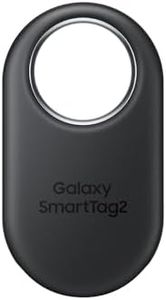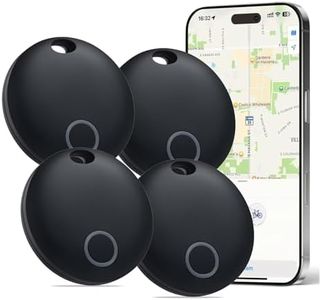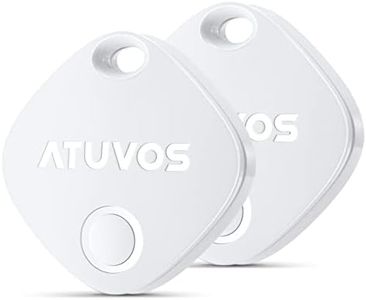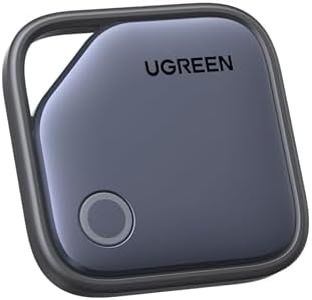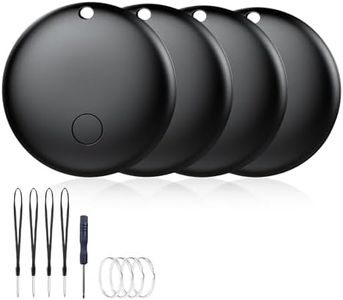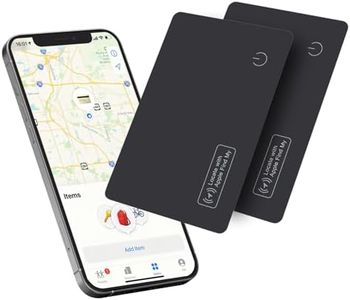We Use CookiesWe use cookies to enhance the security, performance,
functionality and for analytical and promotional activities. By continuing to browse this site you
are agreeing to our privacy policy
10 Best Luggage Trackers
From leading brands and best sellers available on the web.Buying Guide for the Best Luggage Trackers
Choosing the right luggage tracker can give you peace of mind when traveling by helping you locate your bags in case they get misplaced or lost. With technological advancements, luggage trackers can now use GPS, Bluetooth, and other connectivity options to send location updates about your baggage straight to your phone. When picking a luggage tracker, it's important to consider how far you travel, where you travel, and your preferences for locating your luggage. Below are key specifications you should pay attention to while deciding which luggage tracker to buy.Type of Tracking TechnologyThe tracking technology determines how the device communicates its location to you and how accurate it can be. Common options include GPS, Bluetooth, Wi-Fi, or cellular tracking. GPS trackers provide widespread global coverage and are best for international or long-distance travel. Bluetooth trackers, on the other hand, work best over short distances—usually within a room or a building—and might be ideal if you mostly want to keep track of your bags in places like airports or hotels. Wi-Fi or cellular trackers can offer a balance, providing wider coverage than Bluetooth but may not always work everywhere. Consider where and how you travel most often: choose GPS for maximum flexibility, Bluetooth for local tracking, or a combined approach for mixed needs.
Battery LifeBattery life refers to how long the tracker can operate before needing a recharge or battery replacement. Trackers with longer battery life are more reliable, especially for long trips when you might not have the chance to recharge often. Battery life can range from a few days (for active GPS trackers) to a year or more (for Bluetooth trackers with replaceable batteries). If you take long journeys or want to place the tracker in your luggage and forget about it for months, opt for a model with extended battery life. If you don’t mind frequent charging or only need short-term tracking, a shorter battery life might be acceptable.
Location Updates FrequencyThis feature describes how often the device reports or pushes its location to your phone. Frequent updates provide more real-time information but can drain the battery faster, while less frequent updates conserve battery but might leave you with less timely data. If you want constant location monitoring, especially during transfers and layovers, prioritize a device with high-frequency updates. However, for general awareness rather than minute-by-minute tracking, a tracker that checks in every 30 minutes or hour may be sufficient.
Size and WeightThe physical size and weight of a luggage tracker affect how easily you can fit it into your baggage without adding bulk or extra weight. Smaller, lightweight trackers are less likely to be noticed and are easier to attach or hide in your luggage. If you travel with compact bags, or if stealth is important to you, select a slim and light tracker. For traditional suitcases or if you don’t mind a little extra bulk, size may be less of a concern.
App Support and CompatibilityMost trackers work together with a smartphone app to display the location of your luggage. Good app support means easy setup, clear location data, notifications, and perhaps extra features like marking your bags as 'lost' or sharing the location with others. Make sure the tracker’s app is compatible with your phone (iOS, Android, etc.) and check the reviews for user-friendliness and reliability. If you want a seamless experience, prioritize trackers with strong, well-reviewed apps and broad device compatibility.
RangeRange refers to the maximum distance over which the tracker can send data to your phone or the cloud. GPS and cellular trackers usually offer unlimited range as long as they have network coverage, while Bluetooth trackers are limited—typically up to around 100-200 feet in open spaces. If you need to track your luggage over long distances, as in airline travel, go for GPS/cellular. For on-the-spot proximity alerts (like keeping tabs on your bag at a crowded station), Bluetooth range may be sufficient.
Durability and Water ResistanceLuggage trackers may experience rough handling, temperature changes, and moisture exposure. Durable and water-resistant trackers will withstand being knocked around during travel and protect against rain or accidental spills. If you travel frequently or to places with rugged weather, seek trackers advertised as shockproof or waterproof. For occasional or careful use, basic durability might suffice.
Subscription RequirementsSome trackers, especially those with GPS or cellular connectivity, require a monthly or yearly subscription for access to tracking and location data. Others only need a one-time purchase. If you don’t want ongoing commitments, pick a tracker without subscriptions, but understand these may have limited range or features. If you need real-time, global tracking, accepting a subscription-based tracker may be necessary.


